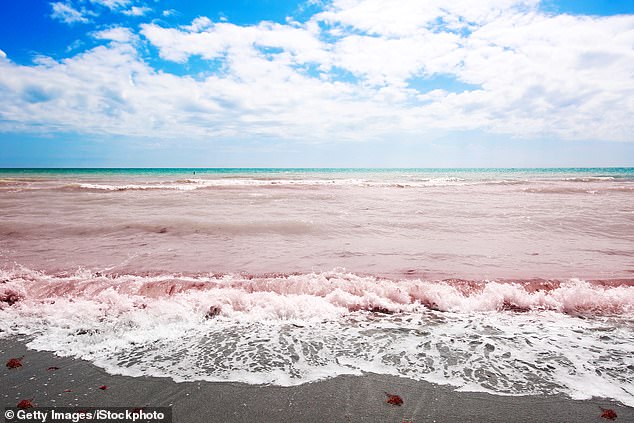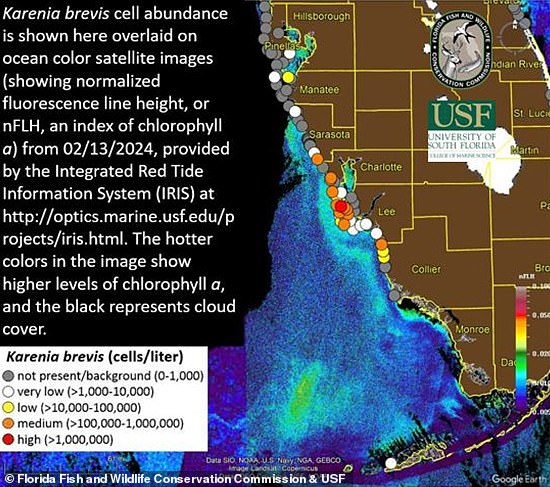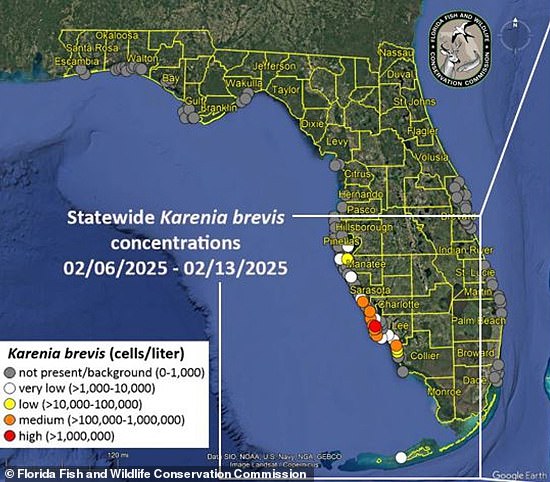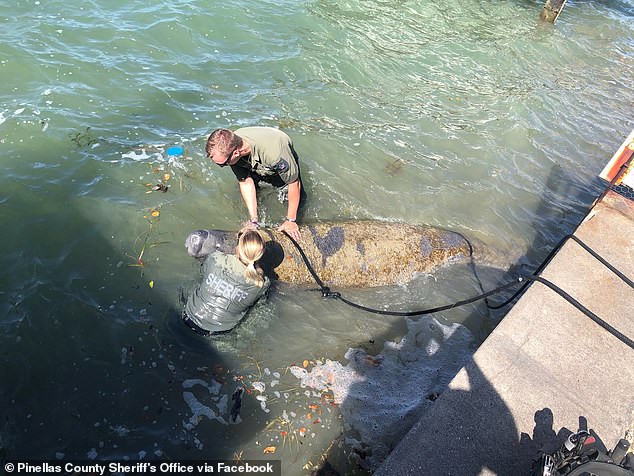- READ MORE: A Thick, Puzzling Fog 'with a Distinct Chemical Odor' Envelops Florida
It worsens off the southwestern coast of the state.
A "red tide" is a type of harmful algal bloom, also known as HAB, which turns the water a reddish brown color due to the uncontrolled growth of the algae species Karenia brevis.
This species produces a toxic substance called brevetoxin, which interferes with nerve cell firing and can lead to severe symptoms.
.
Consuming seafood contaminated with brevetoxin can lead to a variety of health issues, including nausea, vomiting, diarrhea, fluctuations in blood pressure, irregular heartbeat, numbness in the face, dizziness, muscle pain, and skin rashes.
The red tide currently spans over 200 miles from Tampa Bay to Key West, and its movement continues along the southwest coast.
Stirred up nutrient-rich waters that feed the algae last autumn, scientists claim.
Dead fish have already washed ashore on several Florida beaches, and the outbreak is


.
The Florida Fish and Wildlife Conservation Commission is currently tracking the bloom off the state's southwest coast.
In the past week, K. brevis was identified in 50 water samples from southwest Florida, with the highest levels found in samples from Sarasota County, Charlotte County, Lee County, and Collier County.
They were not unusual occurrences. The state usually has at least one such event per year.
They typically appear in late summer and early autumn and continue to exist from winter to spring, lasting for several weeks or months.
Research has shown that water contamination increases the likelihood of such events.
Substances that are rich in nutrients like nitrogen and phosphorus are primarily responsible for the occurrence of more frequent red tides.
These include sewage and chemicals from agriculture or industrial facilities that pollute water on land, which eventually flows into the ocean as runoff.


Algae feeds on the nutrients present in these pollutants, making it easier for their numbers to surge when other favorable conditions occur, such as warm ocean temperatures or storms that stir up more nutrients stored in the ocean's sediment.
Runoff water pollution is a challenging problem to solve, because its source is not a single entity that can be eliminated. Rather, it originates from a multitude of farms, factories, and sewage treatment plants that all discharge chemicals into the groundwater.
We have a significant presence of them in Florida," Milbrandt said. "It's a positive that the state has been investing in engineering technology, and it does have potential, but it's likely that the impact would be confined to smaller blooms.
In 2019, Governor DeSantis established a Red Tide Task Force by appointing 11 researchers and prominent scientists. Subsequently, he has allocated $125 million in funding for the creation of mitigation strategies and technologies.


In addition to addressing water pollution, Milbrandt stated that Florida needs to modify its response to these events when they occur.
'From a response standpoint, it should be kind of an emergency management response like a hurricane,' he said.
In addition to the health risks that red tides pose to people and wildlife, their impacts on tourism, fishing and other industries are also significant.
A bloom in 2018, for instance, resulted in $2.7 billion in tourism losses.
Milbrandt hopes that speaking out will lead to changes in how Florida addresses this widespread environmental issue.
We just want something to happen here," he said. "A statewide response, akin to an emergency management response, would be beneficial.
Read more